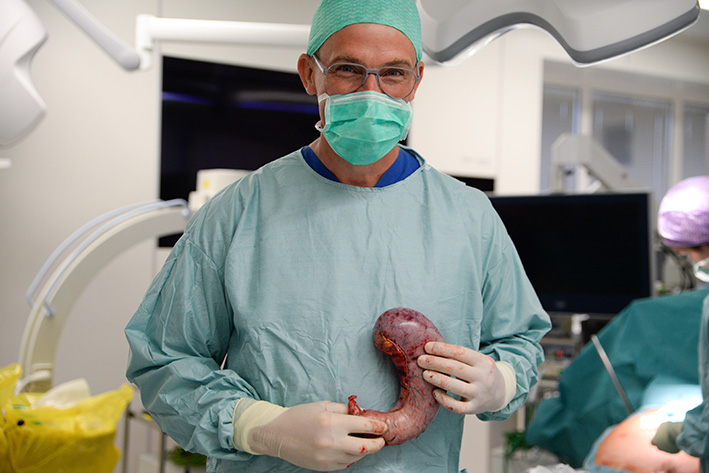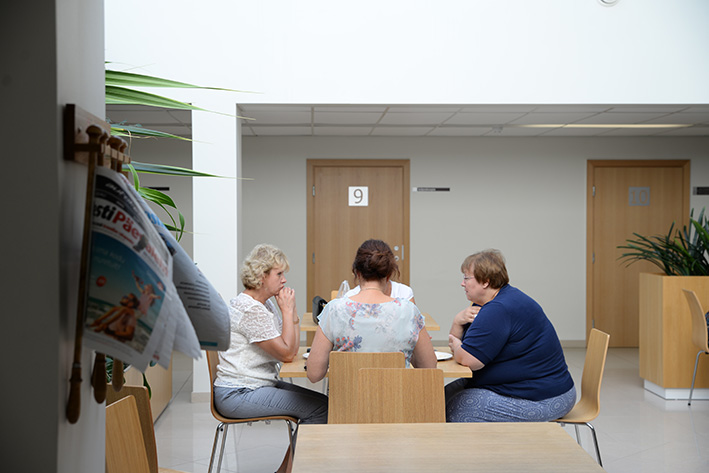Go-Far 2018: Eye on Estonia

The patient can expect to lose about one-third of her body weight, say doctors.
Photo by: Nicole Lim
A stomach for medical tourism
Faced with high prices for surgery at home, Nordic patients find a solution in Estonia
By Prisca Ang
When Swedish national Katarina Kiimalainen decided to lose weight by undergoing bariatric surgery, she learned that she had to fork out a hefty 120,000 Swedish kronas (S$18,000) and wait for two years. Even then, she could not have her preferred type of procedure, a gastric plication surgery.
After reading about weight loss surgeries in Estonia, she decided to visit the Baltic state to undergo gastric plication, which would reduce her stomach size by folding it inwards. She paid about 42,500 Swedish kronas. Two years later, in 2016, she returned to Estonia for another weight loss procedure, this time to remove excess fat and skin from her abdomen and upper arms.
“I’m really happy that I dared to go to Estonia to do these surgeries,” said Ms Kiimalainen, 48, who has lost about 26kg from her previous weight of 109kg.
Ms Kiimalainen is among a growing number of people who are travelling from nearby Scandinavian and Nordic countries — in particular, Sweden and Finland — and as far as the United Kingdom to undergo medical procedures in Estonia. They are wooed by lower prices and Estonia’s good quality of healthcare, said medical experts in the capital Tallinn.
An estimated 1.2 per cent of Estonia’s foreign visitors were in the country for health treatments last year, up from 0.6 per cent in 2016. Last year’s figure was the highest since 2014, which is when the earliest medical tourism related data from government agency Statistics Estonia is available.
These estimates are based on data collected over roughly two months every year. There are no official statistics on the number of medical tourists in Estonia.
Meanwhile, overall tourism rose three per cent last year to 6.1 million visitors, according to the Estonian Tourist Board.

A surgeon completes a bariatric procedure.
Medical travel agencies help patients with selecting surgeons and hospitals,
as well as ferry or plane tickets and hotels.
Foreign patients visit Estonia for orthopedic, plastic and bariatric, or weight loss, surgeries. Bariatric procedures, in particular, are becoming more popular due to growing awareness of Estonia’s health services, said Mr Sten Dubin, managing partner at The Health Clinic, one of the country’s largest medical travel agencies.
“The quality of service and surgeons is very good here due to the Soviet era. It brought good scientists to Estonia,” said Mr Dubin, 34.
He added that Estonia attracts medical tourists as it is close to Scandinavia. It also offers quality healthcare at lower prices than the region, which is known for its high cost of living.
“In medicine, you don’t always want the cheapest. So you come to the next big thing, where the quality meets the price — and out of all the Baltic countries, Estonia is the most advanced,” he said.
Gastric sleeve, a common bariatric procedure in which surgeons remove about 85 per cent of the stomach, costs about 6,000 euros (S$9,400) in Estonia compared to about 9,000 euros in Finland and 80,000 Swedish kronas (S$12,000) in Sweden.
Companies such as Tallinn-based Medicredit also offer loans and payment in monthly installments, increasing patients’ access to medical procedures.
Agencies facilitate medical travel
The Health Clinic profits from commission paid by its surgeons, instead of charging patients such as Ms Kiimalainen extra fees. This helps to keep procedures affordable, said Mr Dubin.
Founded nine years ago, the agency caters to patients from overseas as well as other parts of Estonia. It started out with just 60 foreign patients in 2010, but this number has risen steadily over the years: in 2015, the clinic saw 174 patients from overseas, and last year, it increased to 281.
It brought in some 1.4 million euros in revenue last year, up from 800,000 euros in 2016. It expects to earn over 2 million euros by the end of this year.
The agency’s patient coordinators help to arrange the entire itinerary of patients’ trips: they book ferry and plane tickets; receive the patients when they arrive; shuttle them to the hospitals and hotels; and follow up with the patients after their surgeries.
Patients consult the surgeons at the agency’s office in central Tallinn, before undergoing the procedures at The Health Clinic’s partner hospitals, private hospital Fertilitas and public East-Tallinn Central Hospital. They are also given a surgery information booklet and a menu, created by the agency’s clinical nutrition therapist, that is tailored to their post-surgery dietary requirements.
Medical travel agencies like The Health Clinic allow patients to receive efficient treatment and prompt answers to their queries, as patient coordinators liaise with them closely, said Mr Dubin.
“If you write to the hospital and the surgeon, you can wait for a long time to get an answer. Here, it’s like an information highway, and if patients want to do an operation, they will get it as soon as possible.”
Burgeoning medical tourism industry
Besides Fertilitas and East-Tallinn Central Hospital, there are two hospitals that are popular with patients from overseas. These are the North Estonia Medical Centre and the private Kotka Health Centre. The healthcare community has also set up Medicine Estonia, an organisation that promotes the country’s medical services to patients abroad.
Estonia has two healthcare hubs: its capital, Tallinn, and Tartu, its second largest city, due to the university hospital and medical faculty at the University of Tartu, said Dr Lauri Maisvee, 47, head of Fertilitas’ surgery department.
There is stiff competition among hospitals in Estonia, in both attracting foreign patients and serving the country’s small population of 1.3 million, he added.
“Every patient is so valuable, so you have to earn your reputation.”
Fertilitas saw about 1,000 foreign patients, mostly from Finland, last year. The number of overseas patients has been increasing by about 250 every year over the past few years, said Dr Maisvee.
Plastic surgeries are the most popular procedures among foreign patients, but there has been a rise in the number of bariatric surgeries recently, he added.
Reasons for success
Estonia’s good quality of healthcare, which attracts these patients, is partly due to its efforts to keep up to date with the latest medical technology, said Dr Maisvee.
After Estonia gained independence from the Soviet Union in 1991, it rapidly adopted the latest advancements in technology, and this has benefited its medical sector too, he added.
“We were forced to expand so quickly in such a short period of time. We went from landlines to mobile phones, without having beepers. We didn’t have any cheque books. Instead, we had mobile banking. The same applies to medical technology.”
Better marketing tools, ease of travel and cheaper prices have also contributed to the medical tourism boom here, said Dr Maisvee.
It also helps that many doctors speak multiple languages, which enables them to communicate with foreign patients, he added.

Dr. Kaur, a top bariatric surgeon in Estonia begins on the second of the four surgeries he has lined up that day.
Photo by: Nicole Lim
An example is bariatric surgeon Dr Ilmar Kaur, who speaks Finnish, English, Russian and Estonian. Dr Kaur, who is well-known in Estonia’s healthcare industry, is the head surgeon at Bariatric Services, a private clinic that also caters to foreign patients. The clinic’s surgeons operate at Fertilitas, which houses Bariatric Services’ office, and the North Estonia Medical Centre.
Bariatric Services saw only 10 foreign patients when it started in 2012. It received 155 patients from overseas last year, and expects to see some 200 foreign patients this year.
“In their home countries, patients may be put on long waiting lists, so they seek treatment elsewhere, and at lower costs,” said Dr Kaur, 44.
Less invasive keyhole surgeries, such as the gastric sleeve, are becoming more popular among patients, added Dr Kaur.
In these surgeries, an endoscope is inserted in the body, allowing a surgeon to view its internal environment without making large incisions. With this visual guide, the surgeon can operate on the patient with small surgical instruments, which enter the body in a similar way.
After a bariatric surgery, foreign patients usually stay in the hospital for three nights, so that they have enough time to recover before travelling home, said Dr Andre Trudnikov, head of the Center of General and Oncological Surgery at East-Tallinn Central Hospital.
East-Tallinn receives fewer foreign patients than private hospitals, but it has still seen a 20 per cent annual increase in the number of bariatric patients from overseas, added Dr Trudnikov, 50.
“People find out about our services through technology and word of mouth. It’s taking time, but we are reaching a few hundred foreign patients,” he said.
Looking ahead

About 80 per cent of the patients seeking weight loss surgery are women.
Most are between 20 and 70 years old.
Photo by: Nicole Lim
As people become more mobile, Estonia expects the number of foreign patients in its healthcare system to increase, said the Ministry of Social Affairs, which oversees healthcare in the country.
However, the Ministry’s priority is to ensure that Estonian residents have good access to the healthcare system and to promote “cooperation and networking” of healthcare facilities for treatment of rare conditions, it added.
Estonia’s medical tourism scene faces some challenges as it continues to grow. These include rising competition from neighbours like Latvia and Lithuania, and a slight brain drain as some doctors leave for countries with higher pay, said Dr Trudnikov.
In addition, there are only a few fields in which medical tourism can thrive, as some procedures have high complication rates and long recovery periods, he said.
“For those, it’s quite difficult to go home after just a week. That’s why not all patients travel all around the world for medical care.”
Despite these struggles, doctors expect a further increase in the number of foreign patients in Estonia.
Patients are willing to visit another country to undergo surgeries as they want privacy, especially in fields such as plastic surgery, said Mr Dubin from The Health Clinic.
“You can just come here and nobody will know you. You can hop in and hop out.”
The country’s medical tourism industry will keep growing, due to increasing awareness of its services, more affordable and convenient travel options, as well as long waiting times for some types of surgery in other countries, said Fertilitas’ Dr Maisvee.
He said: “People are more prone to travel, as there are easy and cheap connections now that were not available 10 years ago. They believe that medical services can be purchased overseas easily, reliably and safely.”